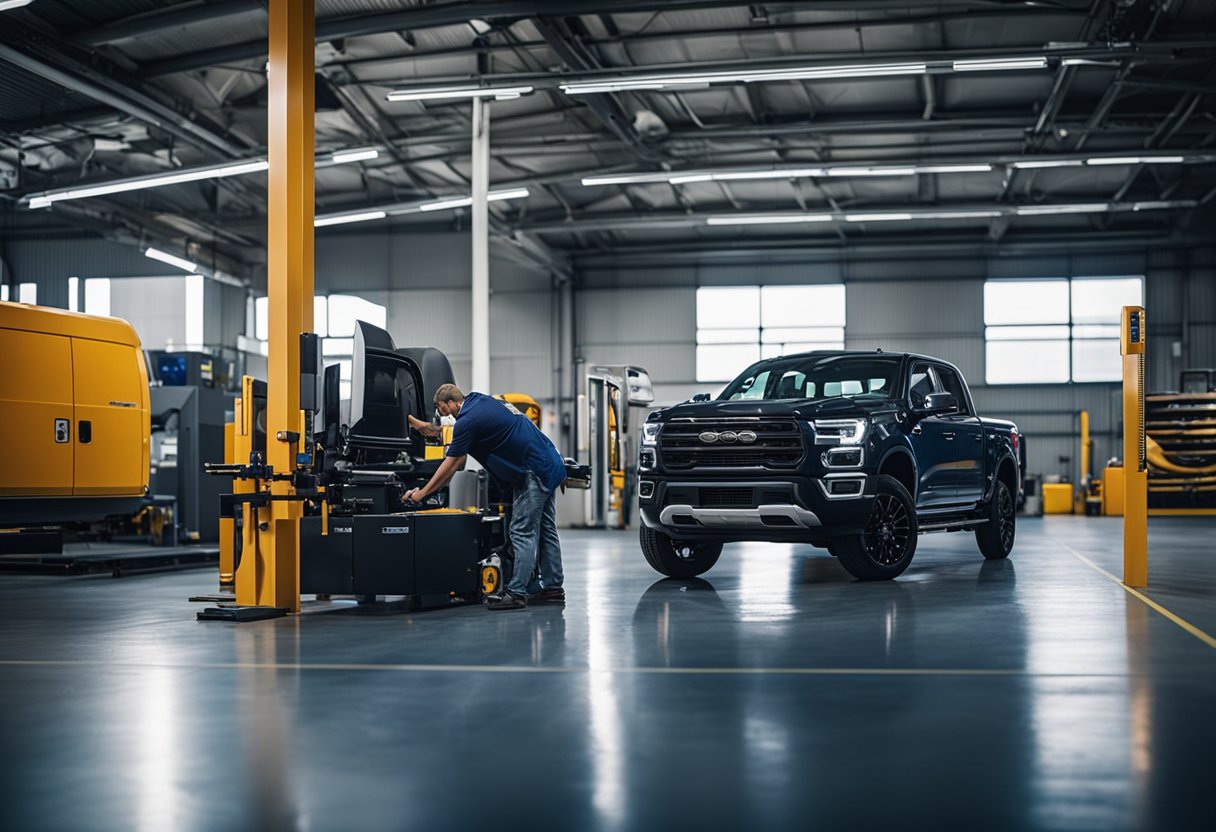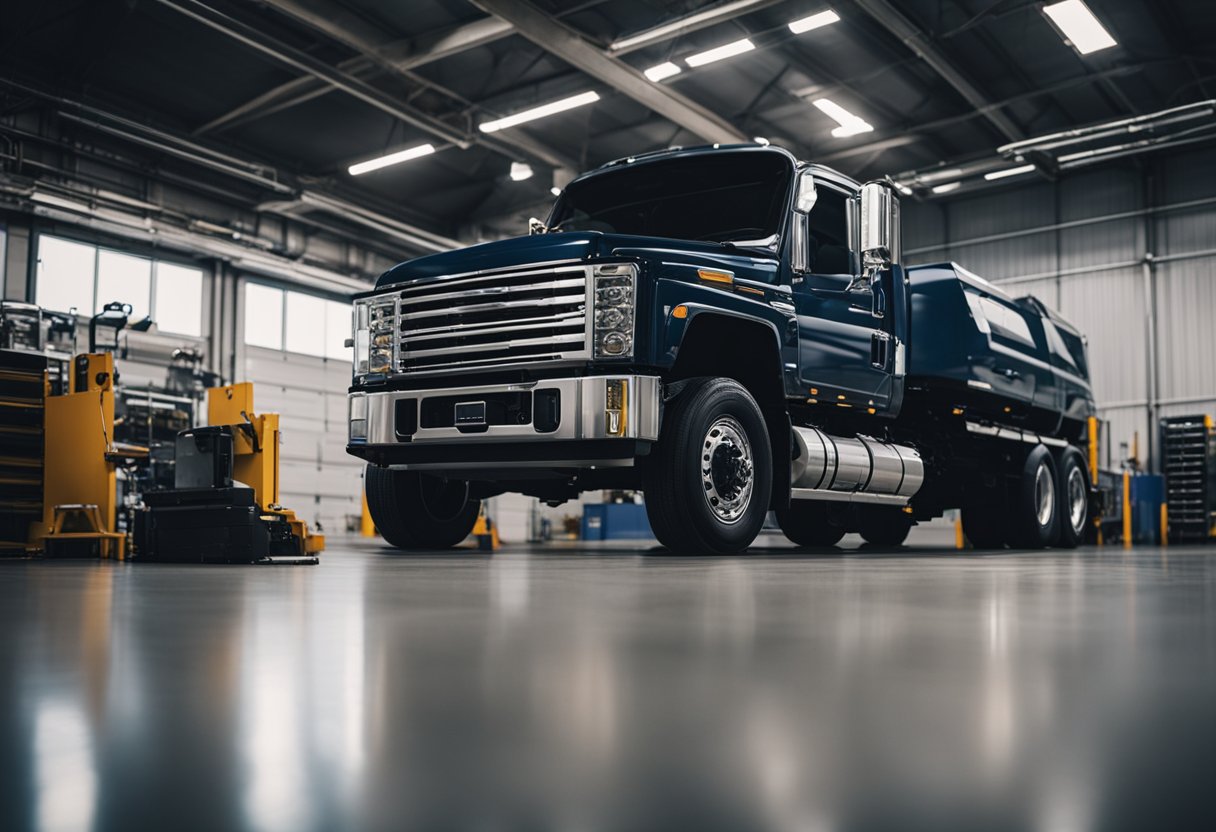When it comes to maintaining a truck, proper wheel alignment is a critical aspect of vehicle care that can vastly improve performance and longevity. The process of aligning a truck involves adjusting the angles of the wheels so that they are set to the manufacturer’s specifications, ensuring the vehicle drives straight and handles properly. Misalignment can lead to uneven tire wear, poor fuel economy, and handling issues, making it important for truck owners to address alignment problems swiftly. The duration of the alignment process can vary significantly; it depends on several factors including the type of truck, the severity of the misalignment, and the specific service provider’s procedures.

The process typically begins with a thorough inspection of the truck’s suspension system to identify any underlying issues that might contribute to alignment problems. This is an essential step to ensure that the alignment lasts and does not recur due to unresolved issues. After any necessary repairs are made, the mechanic will proceed with the actual alignment, which can take anywhere from one to several hours. For an experienced technician using modern alignment equipment, the process can often be completed relatively quickly, but precise adjustments and retests can extend the time needed to ensure the alignment is perfect.
Contents
Key Takeaways
- Proper wheel alignment is crucial for truck performance and lifespan.
- Alignment should be conducted by an experienced technician to ensure accuracy.
- The complete process can vary in time, but precision is key for long-term results.
Importance of Proper Truck Alignment
https://www.youtube.com/watch?v=MFxH-kjbs7Q&embed=true
When I manage the maintenance of a truck, ensuring proper alignment is one of my top priorities. Proper alignment is crucial for safety, as it directly affects the vehicle’s handling. Misalignment can lead to unexpected steering behaviors which challenge driving precision, especially under heavy loads or adverse driving conditions.
Truck alignment is not just about safety, though. It significantly influences performance. A truck that is well-aligned has better stability, responds accurately to steering inputs, and maintains better contact with the road. This helps in transporting cargo efficiently, without unnecessary delays or issues.
From a cost perspective, correct alignment leads to improved fuel efficiency. When tires are not aligned, rolling resistance increases, and so does the fuel consumption. By keeping my truck aligned, I save on fuel costs, which is a substantial part of my operational budget.
Furthermore, misalignment leads to uneven tire wear, reducing tire life considerably. Regular alignment checks prevent this, saving me from the frequent replacement of tires and reducing downtime for the truck. Proper maintenance of tire alignment can effectively extend the lifespan of tires.
Here’s a simplified breakdown of benefits:
| Benefit | Description |
|---|---|
| Safety | Reduced risk of accidents and better handling |
| Performance | Enhanced stability and road response |
| Fuel Efficiency | Decreased rolling resistance, conserving fuel |
| Tire Life | Even tire wear, prolonging tire usability |
I always strive to maintain my truck’s alignment for these reasons, ensuring the truck operates safely, maximally efficient, and cost-effective over its service life.
Fundamentals of Wheel Alignment
https://www.youtube.com/watch?v=awOMTYDptfk&embed=true
Wheel alignment is critical for ensuring my truck handles correctly and tires wear evenly. It involves adjusting the angles of the wheels so that they are set to the car manufacturer’s specification. Proper alignment affects the lifespan of tires, fuel efficiency, and the overall safety of the vehicle.
Camber, Toe, and Caster Explained
Camber is the angle of the wheel in relation to the road when viewed from the front of the truck. If the top of the wheel leans outwards, that’s positive camber; inwards is negative camber. Toe refers to the extent to which the front of the wheels turn inward or outward when viewed from above. Toeing in means the wheels are closer together at the front than at the rear, aiming slightly towards each other, while toeing out is just the opposite. Caster is the angle of steering pivot, seen from the side of the vehicle. If the top pivot leans toward the rear, my truck has positive caster, which can assist in stability at high speeds.
- Camber Angle: It’s necessary to keep this within spec to avoid uneven tire wear and ensure stability in straight-line driving and cornering.
- Toe Angle: Incorrect toe alignment can cause a ‘sawing’ action, scrubbing tread off my tires and reducing their lifespan.
- Caster Angle: Having the proper caster angle enhances steering feel and high-speed stability.
Understanding Suspension Angles
Suspension angles are vital for maintaining the correct relationship between the road and the wheels. While camber, toe, and caster are the most talked about, there’s more to the suspension system. Adjustments in one angle can affect others, as each is interrelated within the truck’s suspension. For example, adjusting the camber on one wheel can inadvertently alter the toe angle. It’s my job to ensure that all suspension angles work in harmony to achieve an optimal wheel alignment, guaranteeing my truck drives straight and reduces tire wear.
Overall awareness of camber, toe, and caster—along with their effects on my truck’s performance—empowers me to maintain my vehicle effectively and secure its longevity and safety on the road.
Common Causes of Misalignment

Before I delve into specifics, it’s essential to understand that misalignment in trucks is primarily caused by two factors: external road hazards and the natural wear and tear of vehicle components.
Effects of Potholes and Road Hazards
When I navigate through roads littered with potholes or unexpected debris, the abrupt jolts and impacts are a common cause of misalignment. Striking a deep pothole or a sharp edge of a curb can abruptly shift the wheel alignment. These intense impacts can lead to changes in the wheel angles, necessitating an alignment adjustment.
Wear and Tear on Suspension Components
Over time, the suspension components of my truck endure wear and tear. The bushings, ball joints, and other suspension parts gradually lose their initial rigidity. This natural degradation can alter the wheel alignment incrementally, leading to a point where corrective measures become necessary to ensure the truck handles correctly and safely.
Signs and Symptoms of Poor Alignment
https://www.youtube.com/watch?v=RCd1jtHISYE&embed=true
When my truck begins to exhibit certain telltale signs, I know it’s time to consider the alignment. The most common indicators include issues in vehicle handling and stability, as well as unusual tire wear patterns.
Vehicle Handling and Stability Issues
If I notice that my truck isn’t driving as smoothly as it should or it’s challenging to maintain a straight path, these might be signs of misalignment. Symptoms can range from the steering wheel being off-center when driving straight to experiencing vibration in the steering apparatus. Another troubling sign is when my vehicle pulls to one side or if there’s a feeling of pulling while steering. All of these point to the possibility that the wheels are not properly aligned, compromising my truck’s handling and stability.
Tire Wear Patterns and Issues
Observing the tires of my truck can reveal a lot about the alignment. Uneven tire wear or irregular tire wear patterns indicate issues that need to be addressed. Here’s a pattern I look out for:
- Feathering: Tires are smooth on one side and sharp on another.
- Camber Wear: Excess wear on the inside or outside edge of the tire.
- Heel/Toe Wear: Tread is worn down more on one side than the other, which can be felt as a saw-toothed or scalloped pattern along the edge of the tire.
When any of these wear patterns are present, it’s a strong sign the truck has an alignment issue that could be causing other symptoms I’ve noticed, such as the vehicle drifting or pulling. It’s essential to get the alignment checked to prevent further tire damage and ensure safe driving conditions.
Alignment Process and Duration
https://www.youtube.com/watch?v=wpWmI_YGqR0&embed=true
In my experience with truck maintenance, I’ve found that the alignment process is essential not only for the longevity of the truck but also for safety. Aligning a truck involves adjusting the angles of the wheels to ensure that they are set to the manufacturer’s specifications. The duration can vary, which leads me to discuss the typical procedure and factors that can affect the alignment time.
Procedure of Aligning a Truck
When I align a truck, I follow certain steps to ensure precision and efficiency. Initially, the truck is driven into the service bay, where the alignment machine awaits. I then attach special clamps to the wheels and link these to the alignment machine which projects lasers to read wheel angles. This data guides my adjustments to the camber, caster, and toe of the wheels to achieve proper alignment. This process can take anywhere from 45 minutes to an hour, assuming no major alignment issues are present.
Factors Affecting Alignment Time
Several factors can influence how time-consuming the alignment will be. Firstly, the condition of the truck’s suspension components can add complexity and time — worn parts may need to be replaced before proceeding. The skill level of the technicians also plays a role; experienced technicians can work faster and spot potential complications early on. Additionally, technical complications with the alignment machine can arise, leading to increased time durations. Finally, a test drive is prudent to ensure that the truck handles correctly post alignment, which can add to the overall time spent on the process.
After-Alignment Considerations

Once I’ve aligned a truck, assessing the alignment’s precision and understanding future maintenance requirements are crucial to ensure the truck remains in optimal driving condition.
Post-Alignment Vehicle Testing
After completing the alignment process, I take the truck for a test drive to verify real-world driving conditions align with the alignment specs. It’s imperative to check that the steering is centered and the truck does not pull to one side. Observing any discrepancies in handling immediately after alignment lets me address them before considering the job done. Once satisfied, I always provide a printed report detailing the alignment angles and the adjustments made, reassuring the customer about the service quality.
Maintenance Tips for Lasting Alignment
To ensure the alignment lasts, regular basic auto maintenance is a cornerstone. I recommend checking tire pressure monthly since incorrect pressure can affect tire wear and alignment. Also, during auto maintenance visits, a quick check of the suspension components for wear can prevent the truck’s alignment from falling out of spec. I advise customers to follow this with a re-evaluation of the truck’s alignment every six months or when it hits another 6,000 miles, whichever comes first. Moreover, a “30-day guarantee” is offered on the alignment, giving my clients peace of mind that any necessary adjustments within this period won’t incur additional charges. Remember, keeping to these maintenance tips is essential for the longevity of the truck’s alignment and overall performance.
Choosing the Right Service for Your Truck

When it comes to maintaining my truck, selecting the right service for tire and alignment needs is crucial. I consider factors such as the type of alignment needed and the quality of the services provided.
Assessing Tire and Alignment Services
When assessing tire and alignment services, I check if the tire shop offers comprehensive options like new tires and tire alignment. It’s important for me to ensure that the shop conducts a thorough tire inspection as part of their service. I look for a service provider that offers both four-wheel alignment and front-end alignment, as the requirements may vary based on my truck’s condition and my driving habits.
Benefits of Professional Alignment
Choosing professional alignment services brings multiple benefits. A proper alignment ensures that my truck’s steering and suspension systems are at optimal performance. I understand that accurate alignment minimizes tire wear, which can save me money on new tires in the long run. Moreover, a well-aligned truck offers a smoother ride and better fuel efficiency, which are significant advantages for me.
By opting for a professional service, I also take advantage of their expertise. These professionals perform a comprehensive steering and suspension inspection, which can reveal underlying issues that might not be immediately apparent. This proactive approach can prevent more extensive problems down the road.
Impact of Alignment on Truck Performance
https://www.youtube.com/watch?v=EYClwTB_08o&embed=true
Proper alignment is a critical aspect of truck maintenance that has a direct impact on various performance parameters. From my experience, I understand that fuel economy is markedly affected by how well a truck’s wheels are aligned. Misalignment causes the engine to work harder, leading to increased fuel consumption. When my truck is aligned correctly, I’ve noticed improvements in gas mileage because the truck doesn’t have to fight rolling resistance.
Drivability and stability are also influenced by how well the truck’s wheels are aligned. When the steering axis is off, even slightly, it can cause my truck to pull to one side, which requires constant steering corrections. This can be exhausting and increases the risk of wear on steering components.
Here’s a quick list that sums up the benefits of keeping my truck well-aligned:
- Fuel Economy: Enhanced due to reduced resistance.
- Tire Life: Even tire wear prolongs tire life.
- Cornering: Improved due to proper rear camber and toe settings.
- Stability: More predictable handling, especially at high speeds or under heavy loads.
With things like cornering and handling, it’s all about balance; an aligned truck distributes weight evenly, which means better grip on the road. Whenever I’ve driven a misaligned truck, the uneven tire wear it caused was clearly evident, impacting both performance and safety. More so, every time my truck is properly aligned, the feel of the ride is smoother and more controlled, which tells me that all parts are working as intended.
Frequently Asked Questions
https://www.youtube.com/watch?v=XvNrVu3Tuow&embed=true
In my experience, understanding the time investment for truck maintenance, such as alignments, is crucial for planning and vehicle care.
What is the typical duration for a truck alignment at a professional service center?
A truck alignment usually takes about one hour to complete at a professional service center, though this can vary slightly depending on the type of truck and the service center’s current workload.
Is it necessary to get an alignment after installing new tires on my truck?
Yes, it’s advisable to have an alignment performed after installing new tires on a truck to ensure even tire wear and proper handling.
Can you complete a wheel alignment in under 10 minutes?
Completing a wheel alignment in under 10 minutes is unrealistic. A proper alignment requires precision and careful adjustments that typically take at least an hour.
What is involved in the truck wheel alignment process?
The truck wheel alignment process involves adjusting the angles of the wheels so that they are set to the truck maker’s specifications, which ensures the vehicle drives straight and reduces tire wear.
How frequently should a truck undergo wheel alignment?
I recommend having a truck undergo wheel alignment every 6,000 to 12,000 miles, or when you notice uneven tire wear, steering pull, or after a significant impact to the suspension.
How long should I expect a tire rotation and balancing to take?
A tire rotation and balancing for a truck typically takes about 30 to 45 minutes to complete when performed by a skilled technician.

